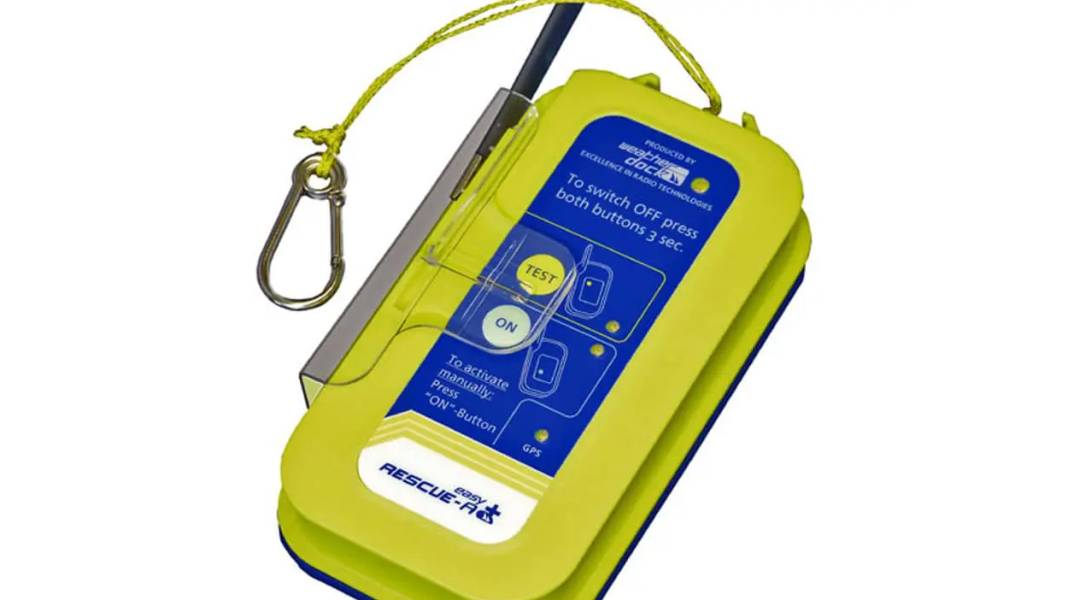Maritime distress transmitter: Incorrect disposal triggers large-scale distress operation on the Ems

Last Friday, a major fire and police operation was triggered in Walchum near the marina. At 2 p.m., the lock keeper in Herbrum received a report from a skipper on the Ems about AIS (Automatic Identification System) signals being received from a maritime distress transmitter that were emanating from the area of the leisure boat harbour in Walchum. The informed rescue coordination centre then assumed that a person was in the water and immediately dispatched a large number of emergency personnel.
On arrival, however, the emergency services were unable to find any signs of a person in the water or the source of the signal. Despite an intensive search in the marina using boats and drones, nothing could be found. The search was therefore extended to the Ems near Walchum.
During the search, a person contacted the local police station and reported that they had disposed of a supposedly defective distress beacon in a rubbish bin in the marina car park the previous day. The emergency services found the distress beacon there and realised that it was still working and was the source of the signal.
Also interesting:
How did the false alarm occur?
The transmitter was the Easyrescue-A040-BW-COM AIS maritime distress transmitter from Weatherdock, a commercially available device that can also be attached to a lifejacket. According to the police, this was also the case here. It is unclear what activated the alarm. The transmitter had been deposited in the barrel the day before. Either it had been activated by being detached from the lifejacket and the alarm had just not been noticed for a long time. Or so much water had collected in the barrel due to rain that the device was triggered.
A total of 16 vehicles, 47 emergency crews and several divers from neighbouring fire brigades were on site. Two drones and four boats were also deployed. Two ambulances and an emergency medical vehicle were also on site, as were the waterway police and staff from the Ems-North Sea Waterways and Shipping Office.
However, the person who caused the alarm did not incur any costs for the large-scale operation, as according to the police it was an emergency operation and the person who caused it did not act with intent.
What to do in the event of incorrect activation?
In the case of a pure AIS alarm, it is sufficient to deactivate the transmitter. The necessary steps can often be found on the device itself. The alarm message then disappears from the plotters after about five to six minutes. Although this alarm message does not automatically trigger the rescue chain, the Bremen Maritime Rescue Coordination Centre can be called by radio or mobile phone and informed of the false alarm if, as in this case, a rescue operation has already begun.
If the device also has DSC (Digital Selective Call), the digital radio call, this automatically triggers the rescue chain, either if the alarm is heard by a coastal radio station itself or is sent to it by other yachts via forwarding. The Maritime Rescue Coordination Centre in Bremen will then investigate the alarm and, in case of doubt, initiate rescue measures.
In this case, the alarm should also be deactivated and a call made to the Maritime Rescue Coordination Centre. In addition, the alarm should be cancelled via VHF radio on channel 16 in order to inform all yachts that may already be on a rescue course. This should be done according to the following scheme:
- An alle Funkstellen / All stations (3x spoken)
- Hier ist / This is
- - MMSI number plus ship name/call sign (spoken once)
- - Position / in position
- - I cancel my distress alert of date ... (date/time in UTC) zurück / I cancel my distress alert of date (date/time in UTC)
- - Captain
- - Date/time in UTC
The same should be done if the distress button on the permanently installed VHF radio is accidentally pressed for too long and an alarm goes out. It is best to wait for the message to be sent once in full so that it does not reach others in fragments, then deactivate the alarm using the CLR button or by switching off the device and inform other radio subscribers and the Bremen Maritime Rescue Coordination Centre as described above.
How are old appliances disposed of safely?
It is best to take them to the dealer. If this is not possible, remove the battery and return it and the device to a suitable collection point.

